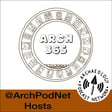Become a Creator today!Start creating today - Share your story with the world!
Start for free
00:00:00
00:00:01

Antikythera Mechanism - Episode 18027
The Antikythera Mechanism is the oldest known analogue computer and was able to track astronomical and astrological movements as well as the four year cycle of ancient Greek Games.
Recommended
Transcript
Introduction to the Podcast
00:00:01
Speaker
You're listening to the Archaeology Podcast Network.
What is the Antikythera Mechanism?
00:00:04
Speaker
The Antikythera Mechanism is the oldest known analog computer and was able to track astronomical and astrological movements, as well as the four-year cycle of ancient Greek games.
About the Arc 365 Podcast and Membership
00:00:17
Speaker
This is episode 27 for January 27, 2018. I'm Chris Webster, and welcome to the Arc 365 podcast, 2018 edition. Arc 365 is a podcast today, every day, in 2018.
00:00:31
Speaker
This network is supported by our listeners. You can become a supporting member by going to arcpodnet.com slash members and signing up. As a supporting member, you have access to high quality downloads of each show and a discount at our future online store and access to show hosts on a members only Slack team.
00:00:49
Speaker
For professional members, we'll have training shows and other special content offered throughout the year.
Discovery and Complexity of the Antikythera Mechanism
00:00:54
Speaker
Once again, go to arkpodnet.com slash members to support the network and get some great extras and swag in the process. That's arkpodnet.com slash members. This episode is written by Christopher Booth. The Antikythera Mechanism was recovered from a shipwreck off the coast of the Greek island of Antikythera in 1902 by archaeologist Valerius Stais.
00:01:17
Speaker
It has been dated by various researchers to either 87 BCE between 150 and 100 BCE and 205 BCE. The shipwreck itself has been dated to approximately 70 to 60 BCE. Detailed x-ray imaging of the mechanism has shown that it has had 37 gear wheels, which meant that it was able, with a knowledgeable user, to follow the movements of both the moon and the sun through the Greek zodiac to predict eclipses and even to model the varied velocity of the moon through its orbit. This variation was only discovered in the second century BCE.
00:01:46
Speaker
The same x-ray imaging has made it possible to count the teeth on the gears and subsequently understand and replicate the basic operation of the device. It is also shown that the complexity of the anti-githrope mechanism is comparable to the complexity of 14th century astronomical clocks.
Understanding the Mechanism's Dials and Cycles
00:02:02
Speaker
The front dial has two concentric circles, with the outer ring marking off the 365-day Egyptian civil calendar, and the inner ring marking the Greek signs of the zodiac with divisions into degrees. On the back, there are five dials tracking the Metonic, Sorrows, Games, Callipic, and Exlegimos cycles.
00:02:21
Speaker
The metonic cycle is very close to 19 years, a period that is nearly a common multiple of the days of the solar year and the days of the lunar month, and is used in the Babylonian calendar. The calypic cycle is an improved version of this. The Saros cycle is a period of approximately 223 months that can be used to predict both solar and lunar eclipses, and the Exiligamo cycle is an alternative to the Saros.
00:02:44
Speaker
The game's dial has been renamed from the Olympiad dial, as it did not track the four-year cycle of the ancient Olympiad, but did track the different four-year cycle, presumably for different Greek games.
Research and Theories on the Antikythera Mechanism
00:02:54
Speaker
In summary, the Antikythera mechanism was designed to predict celestial phenomena according to the theories current at the time. Unfortunately, due to the failings in these theories, recent investigations have shown that the mechanism was not terribly accurate.
00:03:07
Speaker
The mechanism was found as one lump, which later separated into three main sections and which are now further split into 82 fragments after conservation. The quality and complexity of manufacture suggests that the mechanism has undiscovered predecessors made during the Hellenistic period, which is also corroborated by some references to similar mechanisms in ancient texts.
00:03:26
Speaker
In 2008, research by the ongoing Antikythera Mechanism Research Project suggested that the concept for the mechanism may have originated in the colonies of Corinth. The project identified the calendar on the Metonic Spiral as Corinthian.
00:03:40
Speaker
Syracuse, a colony of Corinth, was also the home of Archimedes, which has led the research project to suggest a possible connection between the design of the mechanism and the school of Archimedes. Unfortunately, it has been demonstrated that the calendar on the metallic spiral, whilst of Corinthian type, cannot be that of Syracuse.
Future Research Directions
00:03:57
Speaker
Research on this fascinating device is ongoing and more answers and new insights are coming to light all the time.
Conclusion and Credits
00:04:03
Speaker
Hopefully, we will have a better understanding of the purpose and significance of the Antikythera mechanism soon. Thank you.
00:04:16
Speaker
Thanks for listening to ARC 365. If you want to hear more ARC 365, check out www.arcpodnet.com slash ARC365 for the 2017 and 2018 episodes. Check out arcpodnet.com slash ARC365-G30 for the last 30 episodes. Please subscribe and rate on your service of choice. We're available on iTunes, Stitcher, and Google Play, among others. Support the APN at arcpodnet.com slash members. Thanks for listening, and thanks for being awesome.
00:04:46
Speaker
This show is produced and recorded by the Archaeology Podcast Network, Chris Webster and Tristan Boyle, in Reno, Nevada at the Reno Collective. This has been a presentation of the Archaeology Podcast Network. Visit us on the web for show notes and other podcasts at www.archpodnet.com. Contact us at chrisatarchaeologypodcastnetwork.com.
